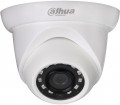Number of LEDs
The number of backlight LEDs (see "Design and capabilities") provided in the camera design.
Theoretically, more LEDs provide more power and, accordingly, range (see below) and efficiency
of IR illumination or LED illumination. However, in fact, such light sources can vary markedly in performance; in addition, a lot also depends on the features of the camera itself. Therefore, in fact, this indicator is a reference, and when choosing, it makes sense to pay attention to parameters that are closer to practice — in particular, the same backlight range (see below).
Operating temperature
The ambient temperature range in which the camera can be used normally.
All modern surveillance cameras normally tolerate temperatures typical for houses / apartments, offices and other premises with similar mild conditions. Therefore, it is worth paying attention to this parameter, first of all, if the device is planned to be used outdoors — or in a room where the temperature does not differ much from the street temperature or, for technical reasons, should be low (freezer warehouse, refrigerated car, etc. ). In such cases, the lower temperature threshold is especially important: for example, almost all outdoor cameras have the ability to work
in cold temperatures below 0 °, but among indoor models such features are much less common. However,
frost-resistant devices(with an allowable temperature of -40 °C and below) can also be found not only among outdoor cameras, but also among “internal” cameras.
As for the upper temperature limit, it is usually not lower than +40 °C, which is quite enough for using the camera in a temperate climate. In some models, this limit reaches +50 °C and even +60 °C, making them suitable even for hot countries. However, note that we are talking exclusively about use in the shade; the possibility of working under direct sunlight should be clarified separately.
Material
The main material used in the construction of the camera body.
— Plastic. Inexpensive and at the same time quite practical material. Plastic is light, quite strong (not as strong as metal, but still quite sufficient for most cases), chemically inert (and therefore not susceptible to corrosion and insensitive to moisture), and also has a relatively low thermal conductivity (which provides additional protection for extreme temperature fluctuations). Due to all this, this material is very popular in indoor chambers (see "Usage"). At the same time, it is somewhat less suitable for outdoor work.
— Metal. The main advantage of metal, in comparison with plastic, in the case of surveillance cameras is high strength and reliability. This allows you to use it even for street models that work in difficult conditions and must have a certain anti-vandal resistance (at least not immediately “give up” when trying to break or break). At the same time, such material is much more expensive, and therefore less common.
Vandal-resistant body
Ruggedized housing providing enhanced protection against damage attempts.
The specific degree of strength may vary. For example, many manufacturers use the IK standard for impact resistance. The highest rating in this standard is IK10, providing protection against impact with an energy of up to 20 J, which corresponds to a 5 kg load falling from a height of 40 cm; more detailed information on IK can be found in special sources. At the same time, cameras that do not have IK certification can also be positioned as vandal-resistant.
Note that even the most
vandalism-resistant housing does not provide absolute protection against damage. However, this feature, anyway, significantly complicates the attacker's task and may even force him to give up trying to permanently spoil the camera. And the purposeful removal of the camera from the system turns out to be a rather difficult and long matter. And in some models, the increased strength of the case can be combined with other features — for example, a sensor that sends an alarm when attempts are made to damage the camera.

